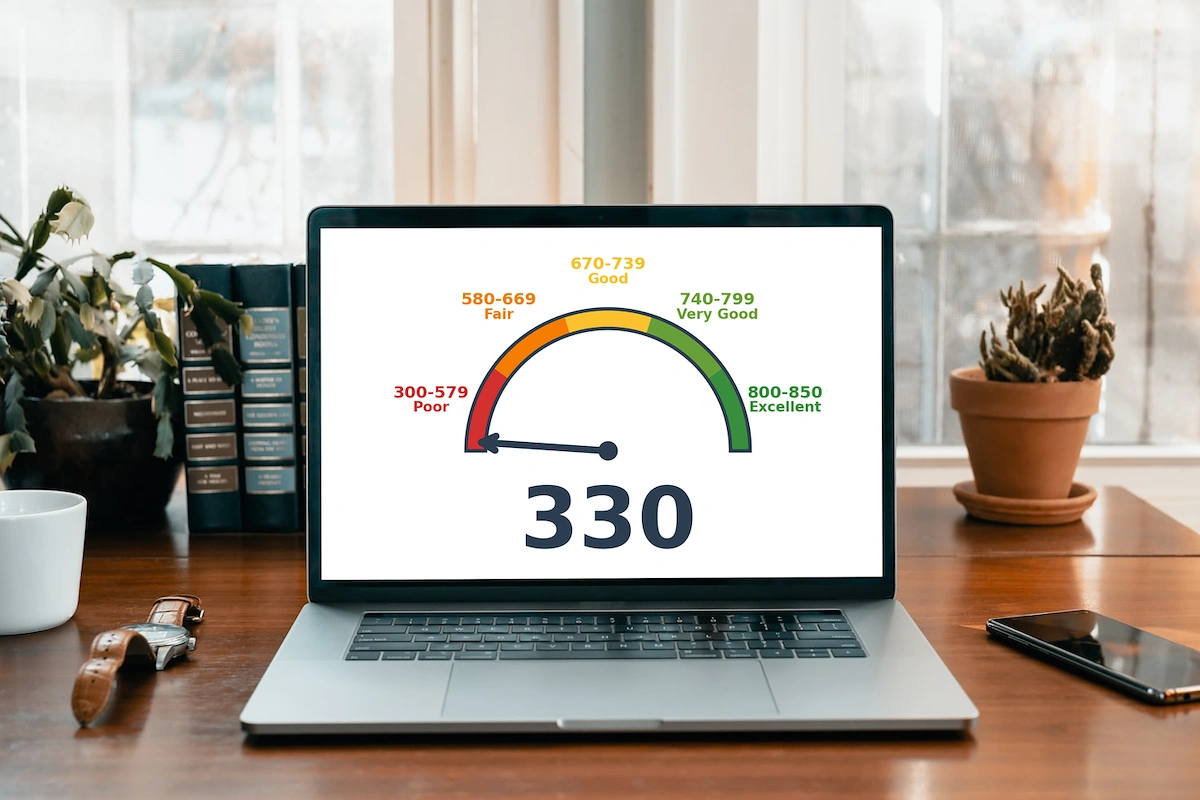
Kudos has partnered with CardRatings and Red Ventures for our coverage of credit card products. Kudos, CardRatings, and Red Ventures may receive a commission from card issuers. Kudos may receive commission from card issuers. Some of the card offers that appear on Kudos are from advertisers and may impact how and where card products appear on the site. Kudos tries to include as many card companies and offers as we are aware of, including offers from issuers that don't pay us, but we may not cover all card companies or all available card offers. You don't have to use our links, but we're grateful when you do!
330 Credit score: What You Need to Know in 2025
July 1, 2025


TL;DR
A 330 credit score offers a clear opportunity to begin building a stronger financial future. This score falls into the “Poor” FICO category, providing a foundational starting point for improvement.
What Does a 330 Credit Score Mean?
A credit score of 330 places you in the "poor" range of the FICO scoring model, which spans from 300 to 850. It's at the lowest end of the spectrum, signaling a very high credit risk to potential lenders. This can create significant financial roadblocks, making it exceptionally difficult to qualify for new credit cards, mortgages, auto loans, or even secure an apartment lease. Lenders view this score as an indicator of a high likelihood of future delinquency.
While facing these challenges can be disheartening, a 330 score is not a permanent financial identity. It represents a starting point from which you can begin to build a stronger credit history. The path forward involves understanding the factors that contributed to the score and recognizing that consistent, positive financial habits can lead to gradual improvement over time. Rebuilding credit is a marathon, not a sprint, but progress is certainly achievable.
Who Has a 330 Credit Score?
While a 330 credit score is significantly below the norm for any demographic, it's helpful to see how average credit scores typically trend with age. Data from 2023 shows a steady increase with each generation:
- Generation Z (ages 18-26): 680
- Millennials (ages 27-42): 690
- Generation X (ages 43-58): 709
- Baby Boomers (ages 59-77): 745
- Silent Generation (ages 78+): 760
Credit Cards With a 330 Credit Score
A credit score of 330 falls into the "poor" range, which can significantly hinder your ability to qualify for most traditional credit cards. Lenders view this score as a high-risk indicator, making them hesitant to approve applications due to concerns about potential defaults. Consequently, your options will likely be restricted to secured credit cards or specialized cards for bad credit, which may come with higher fees and interest rates.
Fintech company Kudos offers AI-powered tools that analyze your unique spending habits and financial preferences to match you with suitable options from a database of nearly 3,000 cards. The platform provides personalized recommendations and insights, helping you understand a card's potential impact on your credit score and whether its benefits align with your financial situation.
Auto Loans and a 330 Credit Score
A 330 credit score places you in the deep subprime category, which can make securing an auto loan challenging. While approval is still possible, you will likely face significantly higher interest rates and less favorable loan terms based on 2025 auto loan rates.
- Super-prime (781-850): 5.25% for new cars, 7.13% for used cars
- Prime (661-780): 6.87% for new cars, 9.36% for used cars
- Non-prime (601-660): 9.83% for new cars, 13.92% for used cars
- Subprime (501-600): 13.18% for new cars, 18.86% for used cars
- Deep subprime (300-500): 15.77% for new cars, 21.55% for used cars
Mortgages at a 330 Credit Score
A 330 credit score is well below the minimum for nearly all mainstream mortgage products. According to current mortgage requirements, even the most lenient FHA loans require a score of at least 500 with a 10% down payment. Most conventional lenders look for a score of 620 or higher, making it virtually impossible to qualify for a traditional home loan with a score in the 300s.
Because lenders price loans based on risk, a very low score would lead to extremely unfavorable terms, if you could find a lender at all. This includes significantly higher interest rates, which can cost tens of thousands more over the life of the loan. You would also face stricter underwriting, higher fees, and requirements for a larger down payment. Options would be limited to specialty or subprime lenders, who operate with much costlier terms.
What's in a Credit Score?
Figuring out what goes into your credit score can feel like trying to solve a complex puzzle, but it's primarily based on a handful of key financial habits. The most common factors include:
- Your payment history tracks whether you have paid past credit accounts on time.
- Credit utilization is the percentage of your available credit that you are currently using.
- The length of your credit history considers the age of your oldest account and the average age of all your accounts.
- Having a healthy mix of credit types, such as credit cards and installment loans, can positively impact your score.
- Recent credit inquiries and newly opened accounts can temporarily lower your score.
How to Improve Your 330 Credit Score
Your credit score plays a vital role in your financial life, but even a very low score can be improved with the right strategy. Taking consistent, positive action is the key to building your creditworthiness and achieving a healthier financial profile.
- Monitor your credit reports. A score in the 300s can sometimes be the result of errors or inaccuracies, and regularly checking your reports allows you to identify and dispute them. This also helps you track your progress as you begin to rebuild your credit.
- Establish automatic bill payments. Your payment history is the single most important factor in your credit score, so ensuring every bill is paid on time is crucial. Setting up automatic payments prevents missed due dates and starts building a positive payment record.
- Apply for a secured credit card. For those with damaged credit, a secured card is an accessible tool that requires a cash deposit as collateral. By making small purchases and paying the bill on time each month, you can demonstrate responsible credit use and add positive history to your report.
- Reduce your credit utilization. If you have existing credit card debt, paying down the balances will lower your credit utilization ratio, which can provide a significant boost to your score. Lenders view high balances negatively, so reducing them shows you can manage debt effectively.
Using a tool like Kudos can help you manage your cards and maximize rewards as you work to improve your credit score.

Supercharge Your Credit Cards
Experience smarter spending with Kudos and unlock more from your credit cards. Earn $20.00 when you sign up for Kudos with "GET20" and make an eligible Kudos Boost purchase.
Editorial Disclosure: Opinions expressed here are those of Kudos alone, not those of any bank, credit card issuer, hotel, airline, or other entity. This content has not been reviewed, approved or otherwise endorsed by any of the entities included within the post.




























.webp)
.webp)
.webp)
.webp)
.webp)

.webp)
.webp)
%20(1).webp)
.webp)